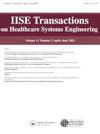从短ECG信号中自动检测心房颤动:一种混合深度学习方法
IF 1.5
Q3 HEALTH CARE SCIENCES & SERVICES
IISE Transactions on Healthcare Systems Engineering
Pub Date : 2021-11-09
DOI:10.1080/24725579.2021.1919249
引用次数: 2
摘要
心房颤动(AF)是最常见的心律失常并发症之一。近年来,研究人员尝试使用深度学习模型,如卷积神经网络(CNN)和/或长短期记忆(LSTM)神经网络来缓解繁琐和耗时的特征提取过程,并获得良好的分类结果。在本文中,我们提出了一个混合CNN-LSTM模型,并使用来自PhysioNet/CinC Challenges 2017数据集的短心电信号来探索和评估四种数据挖掘算法和三种深度学习架构的相对性能。采用原始心电信号、临床诊断特征以及基于时域、频域和非线性心率变异性指标的169个特征进行对比实验。结果表明,通过适当的设计和调整,混合CNN-LSTM模型的性能明显优于其他基准算法。准确率97.42%,灵敏度95.65%,特异性97.14%,AUC (ROC曲线下面积)值0.99,F1评分0.98。一般来说,通过适当的设计和配置,深度学习可以有效地用于自动AF检测,而数据挖掘方法需要领域知识和大量的特征提取和选择过程才能获得满意的结果。然而,大多数机器学习算法,包括深度学习模型,都是作为黑箱来执行任务的,因此几乎不可能确定信号中的哪些特征对分析至关重要。本文章由计算机程序翻译,如有差异,请以英文原文为准。
Automatic atrial fibrillation detection from short ECG signals: A hybrid deep learning approach
Abstract Atrial fibrillation (AF) is one of the most common arrhythmic complications. Recently, researchers have attempted to use deep learning models, such as convolution neural networks (CNN) and/or Long Short-Term Memory (LSTM) neural networks to alleviate the tedious and time-consuming feature extraction process and achieve good classification results. In this paper we propose a hybrid CNN-LSTM model and use the short ECG signal from the PhysioNet/CinC Challenges 2017 dataset to explore and evaluate the relative performance of four data mining algorithms and three deep learning architectures. The original ECG signal, clinical diagnostic features and 169 features based on time domain, frequency domain and non-linear heart rate variability indicators were used for comparative experiments. The results show that with proper design and tuning, the Hybrid CNN-LSTM model performed much better than other benchmarked algorithms. It achieves 97.42% accuracy, 95.65% sensitivity, 97.14% specificity, 0.99 AUC (Area under the ROC curve) value and 0.98 F1 score. In general, with proper design and configuration, deep learning can be effective for automatic AF detection while data mining methods require domain knowledge and an extensive feature extraction and selection process to get satisfactory results. However, most machine learning algorithms, including deep learning models, perform the task as a black box, making it almost impossible to determine what features in the signal are critical to the analysis.
求助全文
通过发布文献求助,成功后即可免费获取论文全文。
去求助
来源期刊

IISE Transactions on Healthcare Systems Engineering
Social Sciences-Safety Research
CiteScore
3.10
自引率
0.00%
发文量
19
期刊介绍:
IISE Transactions on Healthcare Systems Engineering aims to foster the healthcare systems community by publishing high quality papers that have a strong methodological focus and direct applicability to healthcare systems. Published quarterly, the journal supports research that explores: · Healthcare Operations Management · Medical Decision Making · Socio-Technical Systems Analysis related to healthcare · Quality Engineering · Healthcare Informatics · Healthcare Policy We are looking forward to accepting submissions that document the development and use of industrial and systems engineering tools and techniques including: · Healthcare operations research · Healthcare statistics · Healthcare information systems · Healthcare work measurement · Human factors/ergonomics applied to healthcare systems Research that explores the integration of these tools and techniques with those from other engineering and medical disciplines are also featured. We encourage the submission of clinical notes, or practice notes, to show the impact of contributions that will be published. We also encourage authors to collect an impact statement from their clinical partners to show the impact of research in the clinical practices.
 求助内容:
求助内容: 应助结果提醒方式:
应助结果提醒方式:


